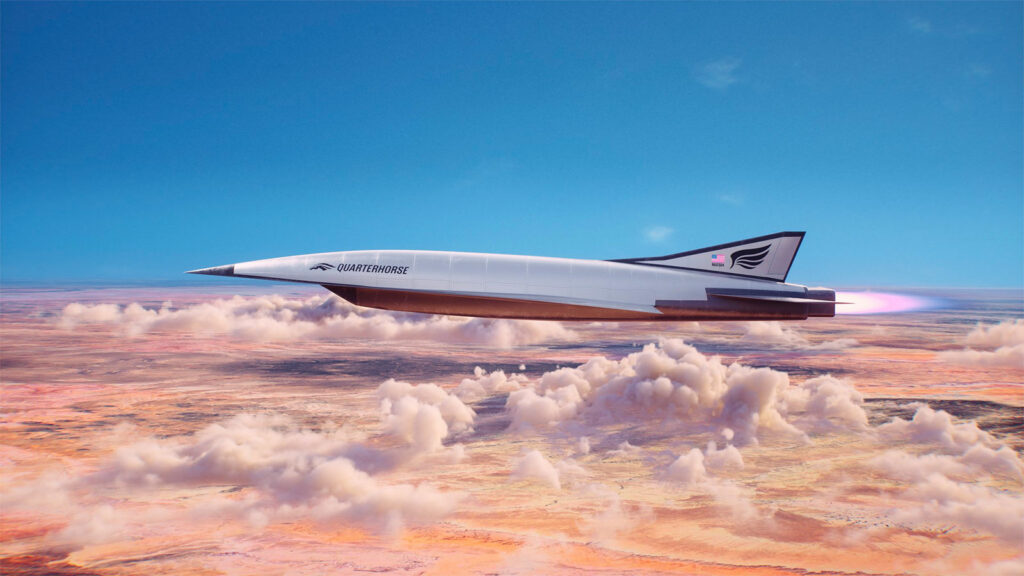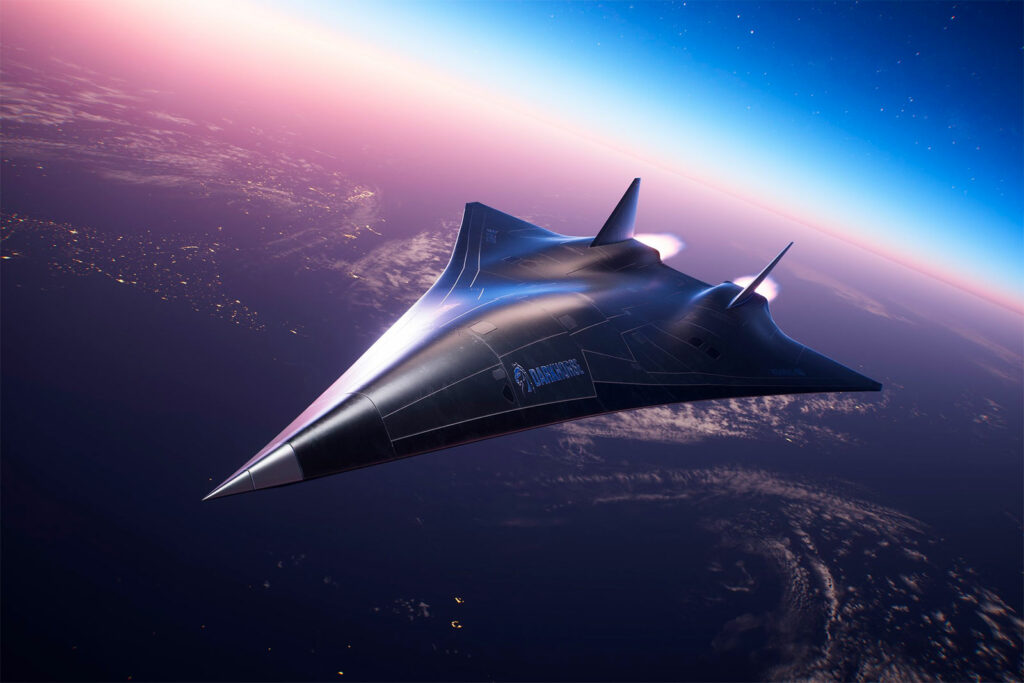The Hermeus Quarterhorse is an uncrewed hypersonic test aircraft designed to validate turbine-based combined cycle engine technology and achieve speeds surpassing Mach 5.
The Hermeus Quarterhorse is an uncrewed hypersonic test vehicle developed to demonstrate advanced propulsion technologies and achieve speeds exceeding Mach 5. Powered by the Chimera engine—a turbine-based combined cycle (TBCC) system—the aircraft transitions from turbojet to ramjet operation, enabling efficient acceleration through various flight regimes. The Quarterhorse program includes multiple iterations, each progressively advancing in complexity to validate subsystems, high-speed flight capabilities, and propulsion performance. The ultimate goal is to surpass the airspeed record held by the SR-71 Blackbird and pave the way for future hypersonic commercial and defense applications.
History of the Development of the Hermeus Quarterhorse
In the late 2010s, the aerospace industry witnessed a resurgence of interest in hypersonic technologies, driven by the potential for rapid global travel and enhanced defense capabilities. Recognizing the strategic advantages of hypersonic flight, Hermeus Corporation was founded in 2018 by AJ Piplica, Skyler Shuford, Glenn Case, and Mike Smayda in Atlanta, Georgia. The company’s mission centered on accelerating air travel through the development of aircraft capable of sustained hypersonic speeds.
The Quarterhorse program was conceived as the inaugural step in this ambitious endeavor. Launched in 2020, the program aimed to develop a series of uncrewed test vehicles to validate the Chimera engine—a turbine-based combined cycle (TBCC) propulsion system designed to operate efficiently across a wide range of speeds. The primary objectives included demonstrating in-flight transition between turbojet and ramjet modes and surpassing the long-standing airspeed record of the SR-71 Blackbird, which had held firm for nearly five decades.
Development commenced with the Quarterhorse Mk 0, a non-flying prototype serving as a dynamic testbed to validate major aircraft subsystems in real-world environments. This approach allowed Hermeus to iteratively assess and refine critical technologies before committing to flight-capable models. In March 2024, the company unveiled the Quarterhorse Mk 1, the first fully integrated, uncrewed aircraft designed for high-speed flight testing. Powered by a General Electric J85 engine, the Mk 1’s primary mission was to demonstrate high-speed takeoff and landing capabilities, a crucial aspect for future hypersonic operations. Flight tests were scheduled to take place at Edwards Air Force Base in California.
The Quarterhorse program received significant support from the U.S. Air Force, which awarded Hermeus a $60 million contract in 2021 to accelerate the development of hypersonic technology demonstrators. This partnership underscored the strategic importance of advancing hypersonic capabilities for national defense and highlighted the potential dual-use applications of the technology in both military and commercial sectors.
As the program progressed, Hermeus planned subsequent iterations, including the Quarterhorse Mk 2 and Mk 3. The Mk 2, powered by a Pratt & Whitney F100 engine, was designed to achieve supersonic speeds and further validate the Chimera engine’s performance. The Mk 3 aimed to incorporate the full TBCC propulsion system, targeting speeds approaching Mach 4 and beyond. Each iteration built upon the lessons learned from its predecessors, embodying Hermeus’s commitment to rapid development cycles and iterative testing.
Throughout its development, the Quarterhorse has not been assigned a NATO reporting name, as it remains a test platform rather than an operational military asset. The program continues to make strides toward achieving its ambitious objectives, with the potential to revolutionize high-speed air travel and redefine the boundaries of aerospace engineering.

Design of the Hermeus Quarterhorse
The design of the Hermeus Quarterhorse is a culmination of cutting-edge aerospace engineering, tailored to meet the rigorous demands of hypersonic flight. Emphasizing both performance and adaptability, the aircraft’s architecture integrates advanced materials, aerodynamics, and propulsion systems to achieve its ambitious objectives.
Airframe and Aerodynamics
The Quarterhorse features a sleek, arrow-like fuselage with an extremely pointed nose, optimizing it for minimal aerodynamic drag at high velocities. The airframe measures approximately 50 feet (15.24 meters) in length, with a wingspan of around 14 feet (4.27 meters). Short, swept-back delta wings are mounted mid-fuselage, providing stability and control during various flight regimes. The empennage includes a single vertical stabilizer and small horizontal tailplanes, contributing to maneuverability and aerodynamic efficiency.
Materials and Thermal Management
Operating at hypersonic speeds subjects the aircraft to extreme thermal stresses. To mitigate this, the Quarterhorse employs high-temperature-resistant materials, such as titanium alloys and advanced composites, in critical areas of the airframe. These materials maintain structural integrity while minimizing weight. Additionally, the aircraft incorporates active cooling systems and thermal protection coatings to dissipate heat generated during high-speed flight, ensuring the longevity and reliability of both structural components and onboard systems.
Propulsion System
Central to the Quarterhorse’s design is the Chimera engine, a turbine-based combined cycle (TBCC) propulsion system. This innovative engine integrates a traditional turbojet with a ramjet, enabling seamless transition between subsonic, supersonic, and hypersonic speeds. The Chimera engine operates in turbojet mode at low speeds before transitioning to ramjet mode as the aircraft accelerates past Mach 3. This design eliminates the need for separate propulsion systems, reducing complexity and weight while maximizing efficiency.
The air intake system is a critical component, designed to optimize airflow at different speed regimes. The adjustable inlets regulate pressure and temperature to ensure smooth engine performance across a wide flight envelope. The exhaust nozzle is also engineered for variable geometry, adapting to different propulsion phases to optimize thrust output.
Landing Gear and Recovery System
Given that the Quarterhorse is an uncrewed aircraft, landing and recovery methods differ from traditional aircraft. It features retractable landing gear designed for autonomous operations. The airframe also includes reinforced sections to accommodate potential high-speed landings and recoveries after test missions.
The Quarterhorse’s modular design allows for rapid prototyping and iterative testing. This adaptability is crucial for a test platform aimed at refining hypersonic flight technologies. Unlike manned hypersonic vehicles, the lack of a cockpit and life-support systems allows more space for fuel and instrumentation.
Performance of the Hermeus Quarterhorse
The Quarterhorse is designed to push the boundaries of hypersonic propulsion and demonstrate sustained speeds exceeding Mach 5. Its engine configuration, aerodynamic efficiency, and structural resilience make it a leading-edge experimental platform.
Speed and Altitude Capabilities
The Quarterhorse aims to surpass the SR-71 Blackbird’s record of Mach 3.3 (4,074 km/h, 2,532 mph) and reach speeds exceeding Mach 5 (6,174 km/h, 3,836 mph). At these velocities, the aircraft will experience intense aerodynamic heating, necessitating advanced thermal management.
Projected operational altitude is approximately 100,000 feet (30,480 meters), positioning the aircraft in the upper stratosphere, where air density is significantly lower. This high-altitude capability allows it to minimize drag and maximize efficiency.
Engine and Power Output
The Chimera engine is a hybrid TBCC propulsion system. In turbojet mode, the engine generates approximately 5,000 lbf (22.24 kN) of thrust, sufficient for takeoff and acceleration through subsonic and supersonic flight. As the aircraft reaches Mach 3, the engine transitions to ramjet mode, where efficiency improves significantly. At peak performance, the Chimera engine produces more than 20,000 lbf (89 kN) of thrust.
The fuel system is optimized for JP-7, a high-energy jet fuel resistant to thermal decomposition at extreme temperatures. JP-7 was also used in the SR-71 Blackbird and is well-suited for hypersonic applications due to its thermal stability.
Range and Endurance
The Quarterhorse is a test aircraft rather than an operational system, so range specifications are secondary to speed and propulsion testing. However, estimates suggest an effective range of 1,500 nautical miles (2,778 km, 1,726 miles) before fuel exhaustion.
Given its high-speed nature, flight durations are relatively short, often less than 30 minutes, with most energy being expended on reaching peak velocity and testing the transition between propulsion modes.
Comparison to Other Hypersonic Platforms
Compared to other hypersonic test vehicles such as the X-51A Waverider (Mach 5.1) and the HTV-2 Falcon (Mach 20), the Quarterhorse offers a reusable and incrementally testable design. The X-51A used a scramjet and was expendable, whereas Quarterhorse employs a hybrid propulsion system that allows multiple test flights.
While it does not reach the speeds of the HTV-2, it provides a more sustainable approach to hypersonic flight testing, reducing costs and increasing frequency of test missions.

Variants of the Hermeus Quarterhorse
The Quarterhorse program features multiple iterations, each progressively enhancing its capabilities.
- Quarterhorse Mk 0 – The first test article, a non-flying prototype used for systems integration, ground testing, and aerodynamic validation.
- Quarterhorse Mk 1 – The first flight-capable variant, powered by the General Electric J85 turbojet. It serves to test high-speed takeoff, landing, and initial aerodynamic behavior.
- Quarterhorse Mk 2 – Designed to reach supersonic speeds, equipped with the Pratt & Whitney F100 engine. This variant focuses on demonstrating sustained high-speed cruise.
- Quarterhorse Mk 3 – The fully integrated TBCC version, featuring the Chimera engine. Expected to achieve speeds beyond Mach 4 and validate full hypersonic propulsion.
Each variant builds upon prior lessons, refining both aerodynamics and propulsion to reach ultimate flight objectives.
Military Missions of the Hermeus Quarterhorse
The Quarterhorse is a testbed for hypersonic propulsion rather than a military asset, but its technologies have direct military implications.
Reconnaissance and Surveillance Potential
A hypersonic reconnaissance drone leveraging Quarterhorse’s TBCC engine could surpass current intelligence-gathering platforms. Its speed and altitude capabilities outclass the SR-71 Blackbird and modern surveillance drones.
If adapted for military roles, a derivative aircraft could conduct high-speed, near-space reconnaissance, delivering intelligence before adversaries can react.
Hypersonic Strike and Weapon Delivery
The U.S. Air Force and DARPA are actively exploring hypersonic weapons and delivery platforms. The Quarterhorse’s engine technology could serve as the foundation for a future uncrewed hypersonic strike aircraft, capable of launching kinetic or energy-based weapons at speeds too fast for interception.
Competitor Aircraft and International Hypersonic Programs
Global adversaries are developing hypersonic vehicles with similar applications:
- China’s DF-ZF Hypersonic Glide Vehicle (Mach 10+)
- Russia’s Avangard Hypersonic Glide Vehicle (Mach 20+)
- India’s HSTDV Scramjet Platform (Mach 6+)
Although the Quarterhorse is not a direct military competitor, its technological breakthroughs could support next-generation U.S. military hypersonic platforms.
Operational Status and Future Prospects
The Quarterhorse is not an operational military aircraft, but its success could lead to a future hypersonic air vehicle program for the U.S. Air Force and commercial space industry. The aircraft remains in active development, with Hermeus planning additional test flights and refinements.
Technical Conclusion
The Hermeus Quarterhorse represents a significant leap forward in hypersonic flight research, focusing on reusable, testable, and scalable propulsion technologies. By integrating a Turbine-Based Combined Cycle (TBCC) engine, the aircraft bridges the gap between traditional turbojets and scramjets, offering a more practical and sustainable approach to hypersonic vehicle development.
With a projected speed exceeding Mach 5, the Quarterhorse aims to surpass existing airspeed records and provide critical data for future military and civilian hypersonic applications. Its incremental development process ensures continuous improvement, setting the stage for next-generation high-speed aircraft.
Though not a direct military asset, the program’s advancements will influence future reconnaissance, strike, and transport aircraft, shaping the future of high-speed aviation.
Back to the experimental aircraft section.